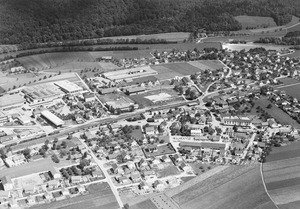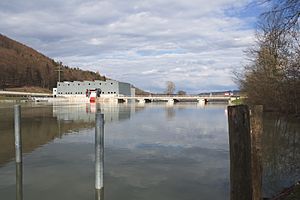Rothrist facts for kids
Quick facts for kids
Rothrist
|
||
|---|---|---|
 |
||
|
||
| Country | Switzerland | |
| Canton | Aargau | |
| District | Zofingen | |
| Area | ||
| • Total | 11.85 km2 (4.58 sq mi) | |
| Elevation | 411 m (1,348 ft) | |
| Population
(Dec 2020 )
|
||
| • Total | 9,290 | |
| • Density | 784.0/km2 (2,030.5/sq mi) | |
| Postal code |
4852
|
|
| Surrounded by | Aarburg, Boningen (SO), Murgenthal, Oftringen, Olten (SO), Strengelbach, Vordemwald | |
| Twin towns | Eggerberg (Switzerland) | |
Rothrist is a cool town, or municipality, located in the Aargau area of Switzerland. It's part of the Zofingen district.
Contents
Rothrist: A Look at Its Past
Rothrist started as a settlement by the Alamanni people. The first time Rothrist was mentioned in writing was in 1263. Back then, it was called Routris.
Early Rulers and Changes
- For a long time, the Counts of Frohburg ruled Rothrist.
- In 1299, the powerful Habsburg family took over.
- Later, in 1415, the area became part of Bern.
- Under both the Habsburgs and Bern, Rothrist was part of the Aarburg court.
- From 1798 to 1802, it was still part of the Canton of Bern.
- In 1803, Rothrist joined the new Canton of Aargau. It became part of the Zofingen district.
Schools and Community Life
- The first schoolhouse in Rothrist was built in 1706. It was located on the Hölzli.
- A larger district school opened in 1917.
- The town's local history museum, called the Heimatmuseum, was built in 1970. It helps people learn about Rothrist's past.
Religious Life in Rothrist
- For many years, Rothrist was part of the Zofingen church area.
- From 1667 to 1714, it was under the church court of Oftringen.
- In 1714, the Reformed church of Rothrist was created. It got its own church building.
- The village's Catholic church was built much later, in 1971.
Growing Economy and Industry
- In the 1700s, most people in Rothrist worked in farming. Many also wove cloth at home.
- In the 1800s, small businesses started near the Pfaffner and Wigger rivers.
- A tough economic time in 1855 forced about 300 people to move to America.
- In 1857, a railway line connected Rothrist to Olten and Bern.
- Five years later, the first big factory was built. It was a spinning mill that used water power from the Rotkanal.
- After 1930, Rothrist saw a big increase in factories and businesses.
- The famous soft drink company Rivella was started here in 1952.
- Because of a major motorway junction, many companies have moved to Rothrist.
- The number of jobs in the town grew a lot, from 1,429 in 1950 to 3,952 in 2005.
Rothrist's Natural Surroundings
Rothrist covers an area of about 11.84 square kilometers (4.57 square miles).
Land Use in the Municipality
- About 33.8% of the land is used for farming.
- Forests cover about 32.8% of the area.
- Buildings and roads take up about 30.6% of the land.
- Rivers and lakes make up about 2.0% of the area.
- A very small part, 0.3%, is unproductive land.
Where Rothrist is Located
The town is in the Zofingen district. It sits along a bend in the Aare river. Rothrist is also west of where the Pfaffnern and Wigger rivers meet. The municipality includes the main village of Rothrist and several smaller scattered villages called hamlets.
Rothrist's Coat of Arms
The town's official symbol, its coat of arms, shows a red shield. On the shield, there is a silver plow blade. Above the plow, there are two silver five-pointed stars. Below the plow, there are green hills.
People of Rothrist
Rothrist has a population of 9,290 people.
Population and Languages
- As of June 2009, about 19.1% of the people living in Rothrist are from other countries.
- Most people in Rothrist speak German (87.4%).
- The next most common languages are Serbo-Croatian (3.2%) and Italian (3.1%).
Age Groups in Rothrist
- About 9.6% of the population are children aged 0 to 9 years old.
- Teenagers aged 10 to 19 make up about 11.3% of the population.
- Adults aged 20 to 59 make up a large part of the population.
- About 10.8% of the people are between 60 and 69 years old.
- Older adults, aged 70 and above, make up about 11.2% of the population.
Homes and Households
- In 2000, there were 2,748 homes and apartments in Rothrist.
- On average, there were 2.4 people living in each home.
- In 2008, about 38.8% of all homes were single-family houses.
Voting and Politics
- In the 2007 national election, the SVP was the most popular party. They received 38.06% of the votes.
- The next most popular parties were the SP and the FDP.
- About 41.2% of eligible voters participated in the election.
Population Growth Over Time
The number of people living in Rothrist has grown a lot over the years:
| Historical population | ||
|---|---|---|
| Year | Pop. | ±% |
| 1764 | 1,121 | — |
| 1850 | 2,620 | +133.7% |
| 1900 | 2,846 | +8.6% |
| 1950 | 4,219 | +48.2% |
| 2000 | 6,869 | +62.8% |
Rothrist's Economy and Jobs
In 2007, the unemployment rate in Rothrist was 2.33%. This means very few people were looking for jobs.
Types of Jobs
- About 58 people work in the primary sector, which includes farming.
- Around 1,754 people work in the secondary sector. This includes jobs in factories and manufacturing.
- The largest number of people, 2,140, work in the tertiary sector. These are service jobs, like in shops, offices, or healthcare.
Commuting to Work
- In 2000, 3,616 people lived in Rothrist and worked.
- About 62.1% of these residents traveled outside Rothrist for work.
- At the same time, 2,151 people came into Rothrist for their jobs.
- About 9.4% of workers used public transportation.
- Most people, 53.3%, used a private car to get to work.
Religion in Rothrist
Based on a 2000 survey:
- About 24.4% of the people were Roman Catholic.
- About 54.7% belonged to the Swiss Reformed Church.
- A small number of people, about 0.23%, were part of the Christian Catholic faith.
Learning and Education
Many adults in Rothrist have a good education. About 67.8% of people aged 25 to 64 have finished high school or gone on to college.
Students in Rothrist
- In the 2008/2009 school year, 532 students were in primary school.
- There were 208 students attending secondary school.
- About 158 students were studying at a university or college level in Rothrist.
The Local Library
Rothrist has a school and municipal library called Schul-u.Gde.Bibliothek Rothrist.
- In 2008, the library had 7,095 books and other media.
- It loaned out 16,365 items that year.
- The library was open 213 days, for about 8 hours each week.
Getting Around Rothrist
Rothrist has its own railway station. It is on the Olten–Bern line. You can catch regular trains from Rothrist to Langenthal and Baden.
See also
 In Spanish: Rothrist para niños
In Spanish: Rothrist para niños







